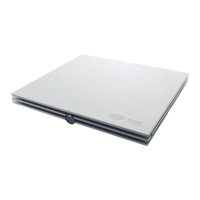Eclipse Additional Information Page 38
CE-Chirp® (Broadband CE-Chirp®)
In Interacoustics ABR system an additional broad band stimulus (a Chirp), can be chosen if license allows
for it. A chirp stimulus counteracts the temporal dispersion in the normal cochlea and thus presents its low-
frequency energy before its high-frequency energy. The design of the chirp is described in detail by Elberling
et al. (2007a), and has the same power spectrum as a standard click. In the study by Elberling and Don
(2008), it was demonstrated that the chirp ABR is up to 1.5-2.0 times larger than the corresponding click
ABR in normal-hearing subjects. The chirp has also been applied for newborn hearing screening and for this
type of hearing testing it has been demonstrated that the chirp is more efficient than the click.
The practical consequence of this is that responses of a desired signal to noise ratio are obtained in a
shorter test time (or that in a fixed test time, the response will have a higher signal to noise ratio) when a
chirp is used rather than a traditional click.
The above description is the first version of the chirp stimuli from Interacoustics and was named CE-Chirp®.
Elberling et al. (2010) demonstrated that the response amplitude can be further improved by changing the
CE-Chirp model for each stimuli level. This is referred to as the level specific chirp - CE-Chirp® LS.
The level specific stimuli has been further tested in the study Elberling et al. (2012), demonstrating that the
response at higher intensities can be further improved by using the CE-Chirp® LS.
NB CE-Chirp® (Narrow-band CE-Chirp®)
The narrow-band stimuli (octave-band Chirps), can optionally be chosen for frequency specific hearing eval-
uation. The design and testing of these octave-band chirps is described by Elberling et al. (2007b). These
narrow-band stimuli are also implemented in the Interacoustics ASSR system.
Like the broad band chirp, narrow band chirps hold the promise of a larger response than their traditional
tone burst counterpart whilst offering approximately similar frequency specificity.
The NB CE-Chirps has also been applied for newborn hearing screening and for this type of hearing testing
it has been demonstrated that the NB CE-Chirps are more efficient than the toneburst (Ferm et al. 2013).
The NB CE-Chirp® stimuli has also been changed into level specific octave wide stimuli. To further help and
assist the clinician in the daily testing, the waveform response from the NB CE-Chirps® LS are placed at the
same location as the click response. So for each stimuli level, the entire CE-Chirp® LS stimulus family pro-
vides a response located at the same latency timing as it would be for the click response (for normal hearing
subjects).
For further information about the latency norms for CE-Chirp® LS and NB CE-Chirp® LS, please refer the
section about latency norms.
Stimulus rate
Here you assign the stimulus rate per second. For neurological tests 11.1 clicks per second is considered a
reasonable stimulation as this low rate improves the neural synchronization for the waves I-V.
For screening and threshold testing, where the presence of wave V rather than accurate morphology is im-
portant, stimulus rates like 45.1 will increase test speed.
A stimulus rate of up to 88.8 is available depending on the test type chosen. This rate is particularly appropri-
ate for evaluations of Multiple Sclerosis or other neurological problems (Cochlear Michrophonic test). It is not
possible to have this many stimulations per second and still provide a recording window of 15ms, so the
waveform may be reduced in length, to match very high stimulation rate requirements.
The option for allowing external trigger appears if the minimum stimulus rate is selected.
The recordings below are recording made with different stimuli rates. A compromise between a fast stimuli
rate and not too much smearing of the wave peak morphology is the goal in threshold tests. Please note
there may be large differences of the wave morphology in relation to age and gender.

